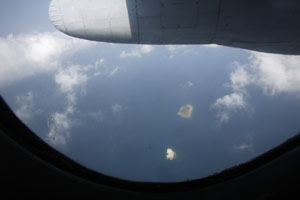Chinese netizens join online hunt for jetliner
By Gao Yuan (China Daily) Updated: 2014-03-15 08:01| Latest news | China effort | Passengers stories | Timeline | Reporter's Log |
| Infographic | Mystery deepens | Airlines' statement | Passport scam | Photos |
Internet users around the globe have joined in the hunt for the missing Malaysia Airlines jetliner as one of the biggest multinational search and rescue campaigns in history came up empty a sixth day.
 |
|
Passengers' and their nationalities: Chinese 154 |
The site asked visitors to flag clues of the vanished Boeing 777-200ER, such as wreckage, oil slicks or life rafts.
No sign of the plane has turned up.
"Five satellites owned by the United States-based company have been used to collect images of the Gulf of Thailand since March 9," said Liu Jingwei, North Asian marketing manager of Digital Globe, which is based in Singapore.
Images of the Strait of Malacca, another presumed location of the plane, have been uploaded on Friday, Liu said.
"We are trying our best to add more pictures of the possible location of the plane. Roughly 24,000 square kilometers of imagery have been uploaded, and another 14,000 sq km will be added by Friday," he said.
Digital Globe claims that every pixel has been looked at by human eyes at least 30 times, indicating that no clues could have been missed.
The company's crowd-sourcing campaign was getting active responses from the Web community in China.
Li Chen, a netizen and Beijing resident, joined the online initiative three days after the plane disappeared.
"I found this website from my friend's micro blog post. At first, I just wanted to see how it worked," said the 28-year-old.
"But after I started to examine the images and seeing the clouds and waves of the Gulf of Thailand, I felt so close to MH370, I couldn't help but check more images."
Liu said that "according to our tech team in the US, Chinese netizens' passion for the mission has been extremely high."
More than 2.3 million volunteers have visited the website since March 9, according to Digital Globe.
Traffic statistics on Tomnod generated from China were still being processed.
Satellites also are actively participating in the search of Malaysia's aircraft.
China deployed 10 satellites to help in the massive search on March 11.
The satellites found three suspicious floating objects the next day, but Malaysian authorities said they weren't debris from the missing jet.
Satellites play a critical role in disaster relief efforts nowadays. In remote or dangerous areas that people can't reach, satellite images are a reliable source of information.
In 2013, Tomnod helped the Filipino government assess more than 100,000 sq km after a catastrophic typhoon hit the country.
But the chances of finding flight MH370 from the Web-based hunt is getting slimmer by the day, especially after a Wall Street Journal report said the jetliner may have airborne for hours after its last confirmed communication.
The report has greatly expanded the search area, which stretches from the western coast of India to the northern tip of Australia.
But Chinese netizens are still examining Tomnod's images tile-by-tile.
"We have to keep digging," said Li, the Chinese netizen.
"It's the only meaningful way for me to contribute to the search," he said.
 |
 |
|
Malaysia says last sighting of plane possibly off West Coast |
Live Report:Malaysia extended search to the Straits of Malacca |

|
 |
Video: How can an airplane disappear? MH370 is not the first aircraft that has disappeared without a trace. |
|
 |
Video: Officials remain puzzled Tension mounted as the search for the missing Malaysian airplane continued. |




